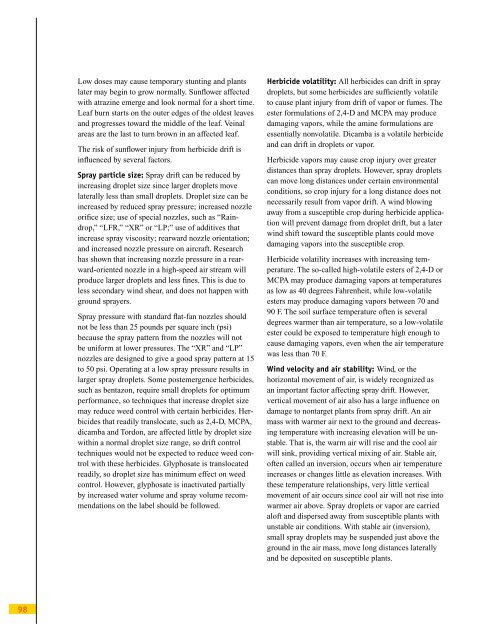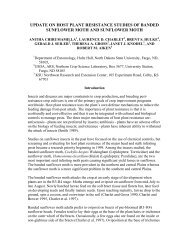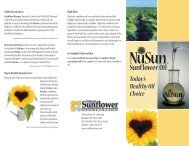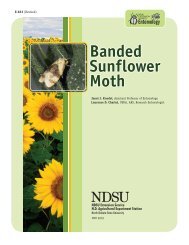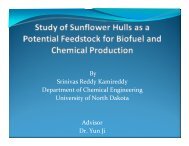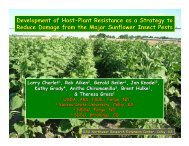Sunflower Production - NDSU Agriculture - North Dakota State ...
Sunflower Production - NDSU Agriculture - North Dakota State ...
Sunflower Production - NDSU Agriculture - North Dakota State ...
Create successful ePaper yourself
Turn your PDF publications into a flip-book with our unique Google optimized e-Paper software.
Low doses may cause temporary stunting and plantslater may begin to grow normally. <strong>Sunflower</strong> affectedwith atrazine emerge and look normal for a short time.Leaf burn starts on the outer edges of the oldest leavesand progresses toward the middle of the leaf. Veinalareas are the last to turn brown in an affected leaf.The risk of sunflower injury from herbicide drift isinfluenced by several factors.Spray particle size: Spray drift can be reduced byincreasing droplet size since larger droplets movelaterally less than small droplets. Droplet size can beincreased by reduced spray pressure; increased nozzleorifice size; use of special nozzles, such as “Raindrop,”“LFR,” “XR” or “LP;” use of additives thatincrease spray viscosity; rearward nozzle orientation;and increased nozzle pressure on aircraft. Researchhas shown that increasing nozzle pressure in a rearward-orientednozzle in a high-speed air stream willproduce larger droplets and less fines. This is due toless secondary wind shear, and does not happen withground sprayers.Spray pressure with standard flat-fan nozzles shouldnot be less than 25 pounds per square inch (psi)because the spray pattern from the nozzles will notbe uniform at lower pressures. The “XR” and “LP”nozzles are designed to give a good spray pattern at 15to 50 psi. Operating at a low spray pressure results inlarger spray droplets. Some postemergence herbicides,such as bentazon, require small droplets for optimumperformance, so techniques that increase droplet sizemay reduce weed control with certain herbicides. Herbicidesthat readily translocate, such as 2,4-D, MCPA,dicamba and Tordon, are affected little by droplet sizewithin a normal droplet size range, so drift controltechniques would not be expected to reduce weed controlwith these herbicides. Glyphosate is translocatedreadily, so droplet size has minimum effect on weedcontrol. However, glyphosate is inactivated partiallyby increased water volume and spray volume recommendationson the label should be followed.Herbicide volatility: All herbicides can drift in spraydroplets, but some herbicides are sufficiently volatileto cause plant injury from drift of vapor or fumes. Theester formulations of 2,4-D and MCPA may producedamaging vapors, while the amine formulations areessentially nonvolatile. Dicamba is a volatile herbicideand can drift in droplets or vapor.Herbicide vapors may cause crop injury over greaterdistances than spray droplets. However, spray dropletscan move long distances under certain environmentalconditions, so crop injury for a long distance does notnecessarily result from vapor drift. A wind blowingaway from a susceptible crop during herbicide applicationwill prevent damage from droplet drift, but a laterwind shift toward the susceptible plants could movedamaging vapors into the susceptible crop.Herbicide volatility increases with increasing temperature.The so-called high-volatile esters of 2,4-D orMCPA may produce damaging vapors at temperaturesas low as 40 degrees Fahrenheit, while low-volatileesters may produce damaging vapors between 70 and90 F. The soil surface temperature often is severaldegrees warmer than air temperature, so a low-volatileester could be exposed to temperature high enough tocause damaging vapors, even when the air temperaturewas less than 70 F.Wind velocity and air stability: Wind, or thehorizontal movement of air, is widely recognized asan important factor affecting spray drift. However,vertical movement of air also has a large influence ondamage to nontarget plants from spray drift. An airmass with warmer air next to the ground and decreasingtemperature with increasing elevation will be unstable.That is, the warm air will rise and the cool airwill sink, providing vertical mixing of air. Stable air,often called an inversion, occurs when air temperatureincreases or changes little as elevation increases. Withthese temperature relationships, very little verticalmovement of air occurs since cool air will not rise intowarmer air above. Spray droplets or vapor are carriedaloft and dispersed away from susceptible plants withunstable air conditions. With stable air (inversion),small spray droplets may be suspended just above theground in the air mass, move long distances laterallyand be deposited on susceptible plants.98


